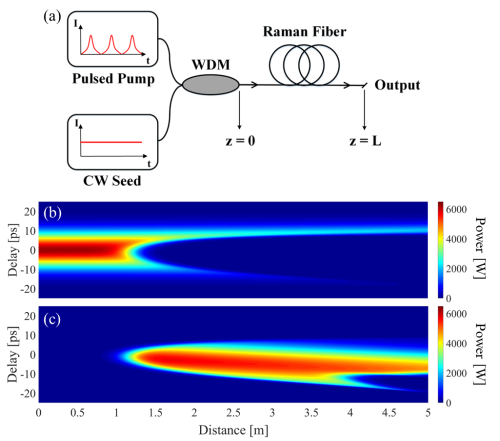A research team from the Shanghai Institute of Optics and Fine Mechanics (SIOM) of the Chinese Academy of Sciences (CAS) developed numerical simulations on optimizing the optical conversion efficiency of nonlinear optical gain modulation (NOGM). They investigated varieties of parameters to find the best condition for obtaining Raman pulses with higher conversion efficiency. The results were published in Optics Express on September 8, 2022.
In this research, researchers use a numerical model based on the generalized nonlinear Schrodinger equation (GNLSE) to simulate the pump and Raman pulse evolutions along the optical fiber through the NOGM process. The NOGM process is simulated by solving the GNLSE with the fourth-order Runge-Kutta method. The schematic of a simulated Raman amplifier is shown in Fig. 1(a). A pulsed pump and a single frequency (SF) continuous-wave (CW) laser were coupled into a piece of Raman fiber.
In the simulations, different parameters including Raman fiber length, seed laser power, pump pulse energy, group velocity dispersion, and pump pulse duration are developed to study how they influence the Raman conversion efficiency and de-chirped pulse duration. The results show that the walk-off effect that existed in the optical fiber has a critical influence on the conversion efficiency. Only when the walk-off speed matches well with the Raman conversion speed can the NOGM process reaches the highest conversion efficiency.
The simulations offer a guide-line to generate femtosecond pulses with μJ-scale pulse energy at a flexible wavelength with more than 85% conversion efficiency by designing proper pump parameters.

Fig. 1. Schematic of the simulated NOGM configuration. WDM: wavelength division multiplexer; a typical example of (b) pump and (c) Raman pulses evolutions through the optical fiber. (Image by SIOM)

Fig. 2. The simulated evolutions of (a) pump pulse and (b) Raman pulse; the pulse envelope and chip of pump and Raman pulse at (c) 4.0 m, (d) 5.7 m and (e) 7.5 m under the pulse energy of 100 nJ and the GVD of 0.001 ps2·m-1. (Image by SIOM)
Article website:
https://doi.org/10.1364/OE.472307
Contact:
WU Xiufeng
General Administrative Office
Shanghai Institute of Optics and Fine Mechanics, CAS
Email: xfwu@siom.ac.cn
Web: http://english.siom.cas.cn/